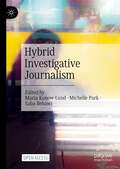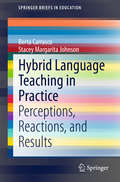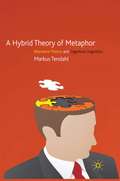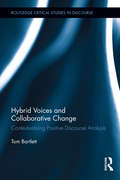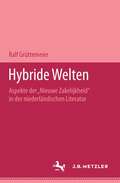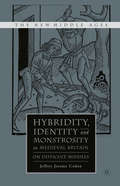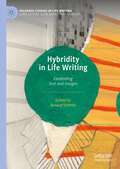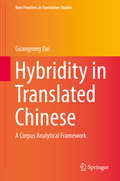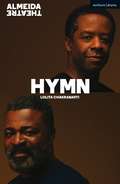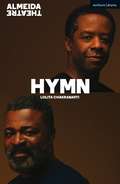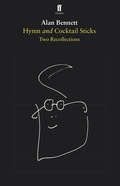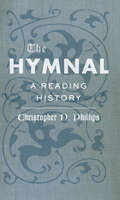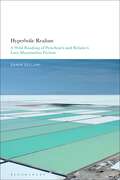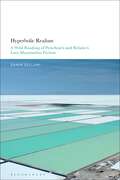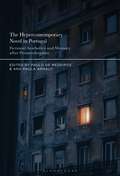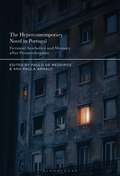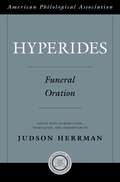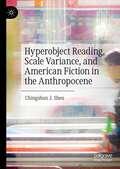- Table View
- List View
Hybrid healing: Old English remedies and medical texts (Manchester Medieval Literature and Culture)
by Lori Ann GarnerThrough combinations of instructive prose and incantatory verse, liturgical rituals and herbal recipes, Latinate learning and oral tradition, the Old English remedies offer hope not only for bodily ailments but also for such dangers as solitary travel, swarming bees and stolen cattle. Hybrid healing works from the premise that the tremendous diversity of Old English medical texts requires an equally diverse range of interpretative methodologies. Through a case study approach, this exploration of early medicine offers a series of close readings tailored specifically to individual remedies, drawing from a range of fields including plant biology, classical rhetoric, archaeology, folkloristics and disability studies. Embracing the endless complexity of these Old English texts, Hybrid healing argues that the healing power of individual remedies ultimately derives from a dynamic and unpredictable process that is at once both deeply traditional and also ever-changing.
Hybrid Investigative Journalism
by Maria Konow-Lund Michelle Park Saba BebawiThis open access book is a rare example of the ethnographic study of investigative journalism. This book explores entrepreneurial attempts to combine traditional investigative journalism with alternative ways of organising this work. It transcends watershed investigative projects in favour of the ways in which new actors (citizens, technologists, bloggers and local reporters, among others) join experienced investigative journalists in experiments with the practices of watchdog journalism in the digital era. Cases include Bristol Cable, Bureau Local and the Korea Center for Investigative Journalism, as well as Forbidden Stories. The book also includes two chapters on the impact of COVID-19 upon the development of cross-disciplinary work in a traditional newsroom and in the larger media ecosystems of both Norway and China. This is a timely book for journalism students, scholars and investigative reporters, who share a passion for this form of journalism.
Hybrid Language Teaching in Practice: Perceptions, Reactions, and Results (SpringerBriefs in Education)
by Berta Carrasco Stacey Margarita JohnsonThis book allows readers to explore the inner workings of a hybrid class from the perspectives of two instructors with different pedagogical orientations, from the students’ perspectives, including learning outcomes and immediately practical teaching tools. The authors meet the challenge of how to preserve pedagogy and content while making good use of digital tools and online opportunities. Language teachers at the secondary and postsecondary level will enjoy the authors’ first person narrative of the creation of a pedagogically-sound hybrid course, practical examples from their courses, as well as student learning outcomes and feedback on the various technological activities. During a year-long study of the authors’ hybrid courses they used a mixed methods design to answers these questions: How does a hybrid course change our teaching? How does the hybrid course affect student learning experiences? What technology-based activities are most effective in our hybrid course?.
A Hybrid Theory of Metaphor: Relevance Theory and Cognitive Linguistics
by M. TendahlA provoking new approach to how we understand metaphors thoroughly comparing and contrasting the claims made by relevance theorists and cognitive linguists. The resulting hybrid theory shows the complementarity of many positions as well as the need and possibility of achieving a broader and more realistic theory of our understanding.
Hybrid Voices and Collaborative Change: Contextualising Positive Discourse Analysis (Routledge Critical Studies in Discourse)
by Tom BartlettIn this study, Bartlett presents a theoretical and descriptive development in the discipline of Critical Discourse Analysis (CDA) extending the recent trend away from critiques of hegemonic practices and towards the description of alternative and minority practices that has been labelled Positive Discourse Analysis (PDA). Through an in-depth case study of intercultural development discourse, the book goes beyond the top-down model of power in CDA and the oppositional approach of PDA to develop a model of power in language as multifaceted and potentially collaborative. This model is used to analyse the particular circumstances of the case study, but is primarily presented as a framework for practical applied linguistic contributions within a wide range of sociocultural contexts. Drawing on social and linguistic theory and methods from a range of functional and applied approaches to language, the book explores the connections between language form and social function, the contextual constraints on discursive action and the potential for the renegotiation of existing discourses and social practices.
Hybrid Voices and Collaborative Change: Contextualising Positive Discourse Analysis (Routledge Critical Studies in Discourse)
by Tom BartlettIn this study, Bartlett presents a theoretical and descriptive development in the discipline of Critical Discourse Analysis (CDA) extending the recent trend away from critiques of hegemonic practices and towards the description of alternative and minority practices that has been labelled Positive Discourse Analysis (PDA). Through an in-depth case study of intercultural development discourse, the book goes beyond the top-down model of power in CDA and the oppositional approach of PDA to develop a model of power in language as multifaceted and potentially collaborative. This model is used to analyse the particular circumstances of the case study, but is primarily presented as a framework for practical applied linguistic contributions within a wide range of sociocultural contexts. Drawing on social and linguistic theory and methods from a range of functional and applied approaches to language, the book explores the connections between language form and social function, the contextual constraints on discursive action and the potential for the renegotiation of existing discourses and social practices.
Hybrid Workflows in Translation: Integrating GenAI into Translator Training (Routledge Focus on Translation and Interpreting Studies)
by Paulina Pietrzak Michał KornackiThis concise volume serves as a valuable resource on understanding the integration and impact of generative AI (GenAI) and evolving technologies on translation workflows. As translation technologies continue to evolve rapidly, translation scholars and practicing translators need to address the challenges of how best to factor AI-enhanced tools into their practices and in translator training programs. The book covers a range of AI applications, including AI-powered features within Translation Management Systems, AI-based machine translation, AI-assisted translation, language generation modules and language checking tools. The volume puts the focus on using AI in translation responsibly and effectively, but also on ways to support students and practitioners in their professional development through easing technological anxieties and building digital resilience. This book will be of interest to students, scholars and practitioners in translation and interpreting studies, as well as key stakeholders in the language services industry.
Hybrid Workflows in Translation: Integrating GenAI into Translator Training (Routledge Focus on Translation and Interpreting Studies)
by Paulina Pietrzak Michał KornackiThis concise volume serves as a valuable resource on understanding the integration and impact of generative AI (GenAI) and evolving technologies on translation workflows. As translation technologies continue to evolve rapidly, translation scholars and practicing translators need to address the challenges of how best to factor AI-enhanced tools into their practices and in translator training programs. The book covers a range of AI applications, including AI-powered features within Translation Management Systems, AI-based machine translation, AI-assisted translation, language generation modules and language checking tools. The volume puts the focus on using AI in translation responsibly and effectively, but also on ways to support students and practitioners in their professional development through easing technological anxieties and building digital resilience. This book will be of interest to students, scholars and practitioners in translation and interpreting studies, as well as key stakeholders in the language services industry.
Hybride Welten: Aspekte der "Nieuwe Zakelijkheid" in der niederländischen Literatur. M&P Schriftenreihe
by Ralf GrüttemeierHybridity, Identity, and Monstrosity in Medieval Britain: On Difficult Middles (The New Middle Ages)
by J. CohenThis study examines the monsters that haunt twelfth-century British texts, arguing that in these strange bodies are expressed fears and fantasies about community, identity and race during the period. Cohen finds the origins of these monsters in a contemporary obsession with blood, both the literal and metaphorical kind.
Hybridity in Life Writing: Combining Text and Images (Palgrave Studies in Life Writing)
by Arnaud SchmittThis book offers new perspectives on text/image hybridity in the context of life writing. Each chapter explores the very topical issue of how writers and artists combine two media in order to enhance the autobiographical narrative and experience of the reader. It questions the position of images in relation to text, both on the page and in terms of the power balance between media. It also shows how hybridity operates beyond a semantic and cultural balance of power, as the combination of text and images are able to produce content that would not have been possible separately. Including a range of life writing and different visual media, from paintings and photography to graphic memoirs and social media, this edited collection investigates the point at which an image, whether fixed or moving, enters the autobiographical act and confronts the verbal form.
Hybridity in the Literature of Medieval England (The New Middle Ages)
by Rosanne P. GasseHybridity in the Literature of Medieval England offers a wide-ranging exploration of hybridity in medieval English literature. Anxiety about hybridity surfaces in characters of mixed ethnic identity in the romances. But anxiety is found also in the intersection of the natural and the supernatural and its site can be located inside the human body’s unstable physical frame, living and dead, as much as in the cultural and social forces at work upon the human body politic at large. Hybridity is unlike other constructs of difference in that, while it is grounded in difference, hybridity points toward sameness. The four types of hybridity studied in medieval English literature show that hybridity can resolve the problems caused by difference. Understanding medieval hybridity can help us to deal with our own contemporary struggles with the mixtures of our own lives and societies.
Hybridity in Translated Chinese: A Corpus Analytical Framework (New Frontiers in Translation Studies)
by Guangrong DaiThis book investigates the characteristics of hybridity in Chinese texts that have been translated from English. It also explores the potential impact of translation and hybridity on written Chinese over the past 70 years. It suggests that English-Chinese translations have introduced more and more hybrid structures into Chinese. This book can help us with understanding language change and development, and it can also shed new light on the translation process and help identify translation norms.
Hymn (Modern Plays)
by Lolita ChakrabartiSometimes it takes a long time to sound like yourself(Miles Davis)Two men meet at a funeral. Gil knew the deceased. Benny did not. Before long their families are close. Soon they'll be singing the same tune.Benny is a loner anchored by his wife and children. Gil longs to fulfill his potential. They develop a deep bond but as cracks appear in their fragile lives they start to realise that true courage comes in different forms.Featuring music from Gil and Benny's lives, Lolita Chakrabarti's searching, soulful new play asks what it takes to be a good father, brother or son.This edition was published to coincide with the world premiere at London's Almeida Theatre in February 2021.
Hymn (Modern Plays)
by Lolita ChakrabartiSometimes it takes a long time to sound like yourself(Miles Davis)Two men meet at a funeral. Gil knew the deceased. Benny did not. Before long their families are close. Soon they'll be singing the same tune.Benny is a loner anchored by his wife and children. Gil longs to fulfill his potential. They develop a deep bond but as cracks appear in their fragile lives they start to realise that true courage comes in different forms.Featuring music from Gil and Benny's lives, Lolita Chakrabarti's searching, soulful new play asks what it takes to be a good father, brother or son.This edition was published to coincide with the world premiere at London's Almeida Theatre in February 2021.
Hymn and Cocktail Sticks
by Alan BennettIt's a dwindling band; old-fashioned and of a certain age, you can pick us out at funerals and memorial services because we can sing the hymns without the book. Alan Bennett writes: In 2001 the Medici Quartet commissioned the composer George Fenton to write them a piece commemorating their thirtieth anniversary. George Fenton appeared in my play Forty Years On and has written music for many of my plays since, and he asked me to collaborate on the commission. Hymn was the result. First performed at the Harrogate Festival in August 2001, it's a series of memoirs with music. Besides purely instrumental passages for the quartet, many of the speeches are under-scored, incorporating some of the hymns and music I remember from my childhood and youth. The text includes both words and music. Hymn is coupled with Cocktail Sticks, an oratorio without music that revisits some of the themes and conversations of Alan Bennett's memoir A Life Like Other People's. A son talks to his dead father as his mother yearns for a different life. It's funny, tender and sad. The pinnacle of my social life is a scrutty bit of lettuce and tomato and some tinned salmon. Mind you, I read in Ideal Home that if you mix tinned salmon with this soft cheese you can make it into one of those moussy things. Shove a bit of lemon on it and it looks really classy.
The Hymnal: A Reading History
by Christopher N. PhillipsIt stands barely three inches high, a small brick of a book. The pages are skewed a bit, and evidence of a small handprint remains on the worn, cheap leather covers that don;€™t quite close. The book bears the marks of considerable use. But why;¢;‚¬;€?and for whom;¢;‚¬;€?was it made? Christopher N. Phillips;€™s The Hymnal is the first study to reconstruct the practices of reading and using hymnals, which were virtually everywhere in the eighteenth and nineteenth centuries. Isaac Watts invented a small, words-only hymnal at the dawn of the eighteenth century. For the next two hundred years, such hymnals were their owners;€™ constant companions at home, school, church, and in between. They were children's first books, slaves;€™ treasured heirlooms, and sources of devotional reading for much of the English-speaking world. Hymnals helped many people learn to memorize poetry and to read; they provided space to record family memories, pass notes in church, and carry everything from railroad tickets to holy cards to business letters. In communities as diverse as African Methodists, Reform Jews, Presbyterians, Methodists, Roman Catholics, and Unitarians, hymnals were integral to religious and literate life. An extended historical treatment of the hymn as a read text and media form, rather than a source used solely for singing, this book traces the lives people lived with hymnals, from obscure schoolchildren to Emily Dickinson. Readers will discover a wealth of connections between reading, education, poetry, and religion in Phillips;€™s lively accounts of hymnals and their readers.
The Hymnal: A Reading History
by Christopher N. PhillipsIt stands barely three inches high, a small brick of a book. The pages are skewed a bit, and evidence of a small handprint remains on the worn, cheap leather covers that don;€™t quite close. The book bears the marks of considerable use. But why;¢;‚¬;€?and for whom;¢;‚¬;€?was it made? Christopher N. Phillips;€™s The Hymnal is the first study to reconstruct the practices of reading and using hymnals, which were virtually everywhere in the eighteenth and nineteenth centuries. Isaac Watts invented a small, words-only hymnal at the dawn of the eighteenth century. For the next two hundred years, such hymnals were their owners;€™ constant companions at home, school, church, and in between. They were children's first books, slaves;€™ treasured heirlooms, and sources of devotional reading for much of the English-speaking world. Hymnals helped many people learn to memorize poetry and to read; they provided space to record family memories, pass notes in church, and carry everything from railroad tickets to holy cards to business letters. In communities as diverse as African Methodists, Reform Jews, Presbyterians, Methodists, Roman Catholics, and Unitarians, hymnals were integral to religious and literate life. An extended historical treatment of the hymn as a read text and media form, rather than a source used solely for singing, this book traces the lives people lived with hymnals, from obscure schoolchildren to Emily Dickinson. Readers will discover a wealth of connections between reading, education, poetry, and religion in Phillips;€™s lively accounts of hymnals and their readers.
Hyperbolic Realism: A Wild Reading of Pynchon's and Bolaño's Late Maximalist Fiction
by Dr. Samir SellamiWhat comes after postmodernism in literature?Hyperbolic Realism engages the contradiction that while it remains impossible to present a full picture of the world, assessing reality from a planetary perspective is now more than ever an ethical obligation for contemporary literature. The book thus examines the hyperbolic forms and features of Thomas Pynchon's Against the Day and Roberto Bolaño's 2666 – their discursive and material abundance, excessive fictionality, close intertwining of fantastic and historical genres, narrative doubt and spiraling uncertainty – which are deployed not as an escape from, but a plunge into reality. Faced with a reality in a permanent state of exception, Pynchon and Bolaño react to the excesses and distortions of the modern age with a new poetic and aesthetic paradigm that rejects both the naive illusion of a return to the real and the self-enclosed artificiality of classical postmodern writing: hyperbolic realism.
Hyperbolic Realism: A Wild Reading of Pynchon's and Bolaño's Late Maximalist Fiction
by Dr. Samir SellamiWhat comes after postmodernism in literature?Hyperbolic Realism engages the contradiction that while it remains impossible to present a full picture of the world, assessing reality from a planetary perspective is now more than ever an ethical obligation for contemporary literature. The book thus examines the hyperbolic forms and features of Thomas Pynchon's Against the Day and Roberto Bolaño's 2666 – their discursive and material abundance, excessive fictionality, close intertwining of fantastic and historical genres, narrative doubt and spiraling uncertainty – which are deployed not as an escape from, but a plunge into reality. Faced with a reality in a permanent state of exception, Pynchon and Bolaño react to the excesses and distortions of the modern age with a new poetic and aesthetic paradigm that rejects both the naive illusion of a return to the real and the self-enclosed artificiality of classical postmodern writing: hyperbolic realism.
The Hypercontemporary Novel in Portugal: Fictional Aesthetics and Memory after Postmodernism
by Paulo de Medeiros and Ana Paula ArnautThe first volume of critical essays on the contemporary Portuguese novel in English, this book theorizes the concept of the 'hypercontemporary' as a way of reading the novel after its postmodern period. This inquiry into the notion of the hypercontemporary in its literary and cultural articulations analyzes a varied group of works representative of the most vibrant novels published in Portugal since 2000. The editors' introductory chapter theorizes the concept of the hypercontemporary as one way of looking at the novel after its postmodern period – especially in its relation to questions of violence, memory and performativity. These essays show how the Portuguese novel has evolved in the past 25 years, and how, in their diversity, most of these novels exhibit several common traits, including new topics and writing strategies – sometimes developing further entropic lines characteristic of many Postmodern narratives – and themes of violence, rapid transformation, and the many threats to a contemporary world that seems mass-produced due to greater technological advances. Readings also discuss the use of innovative graphic forms available from current print technologies and global networks. The Hypercontemporary Novel in Portugal provides a necessary understanding of the current literary landscape of Portugal and, in the process, the aesthetics of hyperrealism or post-postmodernism.
The Hypercontemporary Novel in Portugal: Fictional Aesthetics and Memory after Postmodernism
The first volume of critical essays on the contemporary Portuguese novel in English, this book theorizes the concept of the 'hypercontemporary' as a way of reading the novel after its postmodern period. This inquiry into the notion of the hypercontemporary in its literary and cultural articulations analyzes a varied group of works representative of the most vibrant novels published in Portugal since 2000. The editors' introductory chapter theorizes the concept of the hypercontemporary as one way of looking at the novel after its postmodern period – especially in its relation to questions of violence, memory and performativity. These essays show how the Portuguese novel has evolved in the past 25 years, and how, in their diversity, most of these novels exhibit several common traits, including new topics and writing strategies – sometimes developing further entropic lines characteristic of many Postmodern narratives – and themes of violence, rapid transformation, and the many threats to a contemporary world that seems mass-produced due to greater technological advances. Readings also discuss the use of innovative graphic forms available from current print technologies and global networks. The Hypercontemporary Novel in Portugal provides a necessary understanding of the current literary landscape of Portugal and, in the process, the aesthetics of hyperrealism or post-postmodernism.
Hyperides: Funeral Oration (Society for Classical Studies American Classical Studies)
by Judson HerrmanHyperides' Funeral Oration is arguably the most important surviving example of the genre from classical Greece. The speech stands apart from other funeral orations (epitaphioi) in a few key respects. First, we have the actual text as it was delivered in Athens (the other speeches, with the possible expection of Demosthenes 60, are literary compositions). Next, in contrast to other orations that look to the past and make only the vaguest mention of recent events, Hyperides' speech is a valuable source for the military history of the Lamian War as it captures the optimistic mood in Athens after Alexander's death. Finally, the speech has been singled out since Longinus' time for its poetic effects. This volume is a new critical edition and commentary of the speech, written for scholars and graduate students in classics and ancient history. Although Hyperides ranked nearly as high as Demosthenes in the canon of Attic orators and his funeral oration will make the speech much more accessible to a wide range of scholars. The text is based on a full examination of the papyrus and includes an apparatus criticus, with a complete listing of all conjectures in a separate appendix. The translation is clear and accurate and the commentary provides a mixture of historical, cultural, and literary material.
Hyperion, or the Hermit in Greece (Open Book Classics #10)
by Howard GaskillFriedrich Hölderlin’s only novel, Hyperion (1797–99), is a fictional epistolary autobiography that juxtaposes narration with critical reflection. Returning to Greece after German exile, following his part in the abortive uprising against the occupying Turks (1770), and his failure as both a lover and a revolutionary, Hyperion assumes a hermitic existence, during which he writes his letters. Confronting and commenting on his own past, with all its joy and grief, the narrator undergoes a transformation that culminates in the realisation of his true vocation. Though Hölderlin is now established as a great lyric poet, recognition of his novel as a supreme achievement of European Romanticism has been belated in the Anglophone world. Incorporating the aesthetic evangelism that is a characteristic feature of the age, Hyperion preaches a message of redemption through beauty. The resolution of the contradictions and antinomies raised in the novel is found in the act of articulation itself. To a degree remarkable in a prose work of any length, what it means is inseparable from how it means. In this skilful translation, Gaskill conveys the beautiful music and rhythms of Hölderlin’s language to an English-speaking reader.
Hyperobject Reading, Scale Variance, and American Fiction in the Anthropocene
by Chingshun J. SheuThis book proposes a model of reading called hyperobject reading that bridges the Anthropocene scale variance between humans and humanity by focusing on the large-scale problems and phenomena themselves. Hyperobject reading draws on narratology and reader-response theory, as well as newer developments such as the postcritical turn and object-oriented ontology. The theoretical introduction sets out the building blocks of hyperobject reading. Chapter 2 intervenes in critical disability studies and debates about the ecosomatic paradigm; Chapter 3 intervenes in debates about technological evolution, analogue vs. digital subjectivity, and affect theory; and Chapter 4 intervenes in debates about autofiction, contemporary metafiction, and the position and role of the narrator in first-person narratives where the narrator and protagonist can be distinguished. The analytical conclusion sketches the conceptual anatomy of the hyperobject and three possible responses. No part of the Earth today is free from human influence, but literary success suggests effective real-world strategies.

